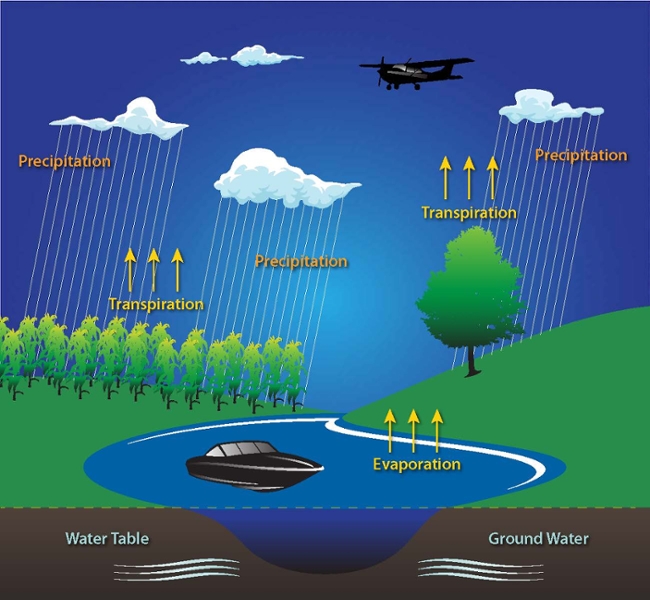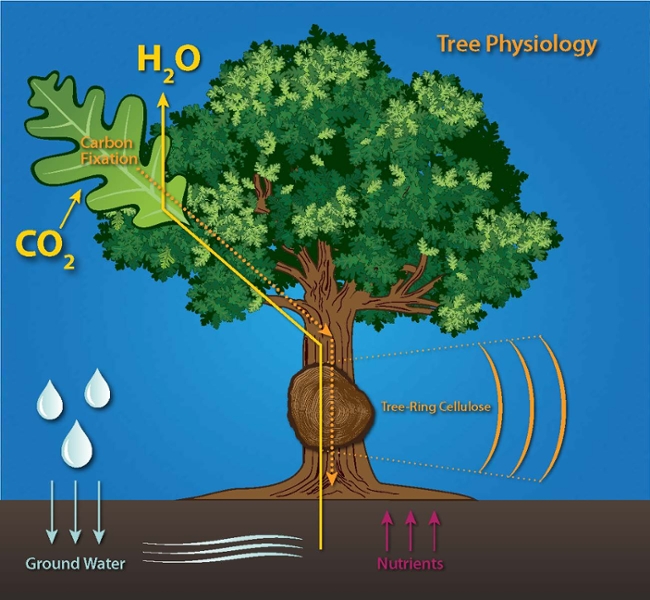Research
Overview
Dr. Welp's lab studies the exchange of both water and carbon between the land surface and the atmosphere and the intersection of these cycles in the terrestrial biosphere. Many of our research projects use stable isotopes to help isolate the influences of different processes. This is what isotope tracers are well suited for.
Water cycle studies

Intensification of the hydrologic cycle is expected with increasing global temperatures and trends in agricultural management practices may have large-scale consequences as well. Atmospheric water vapor has been increasing over the central U.S. and summer storms have become more frequent and intense. Isotopic tracer applications have the potential to separate plant transpiration or lake evaporation influence on the atmosphere and to quantify continental moisture recycling. Isotopic water mass balance of a Siberian river showed that a large part of summer evapotranspiration was fueled by snowmelt (Welp et al. 2005). Dr. Welp was one of the first in the field to apply laser-based optical measurements of isotopes of water vapor. Her work identified a number of features of the water budget of the atmospheric boundary layer, including temporal variability in the transpiration isotopic flux of water (Welp et al., 2008) and the role of the diurnal boundary layer variability in deuterium excess (Welp et al., 2012).
Recent work in preparation examines vertical profiles of water vapor isotopes through the boundary layer to the free troposphere measured aboard Purdue's Airborne Laboratory for Atmospheric Research (ALAR). The lab is also investigating the isotopic composition of evaporation from the Great Lakes abord the Blue Heron R/V (UNOLS ship operated by the University of Minnesota, Duluth).
Carbon cycle studies

The oxygen and carbon isotopes of atmospheric CO2 and plant organic matter provide clues about leaf-level gas exchange of CO2 and water with the atmosphere. Oxygen isotopes of CO2 in air (18O/16O ratio) has the potential to partition net ecosystem CO2 fluxes into photosynthesis and respiration (Welp et al., 2006). This approach leverages the fact that there are differences in the water isotopes between the soils and plant leaves and that CO2 picks up those signatures during respiration and photosynthesis. An analysis of the long-term record of oxygen isotope ratios in the atmospheric flask monitoring stations (Welp et al., 2011) showed a clear signal of El Nino (or ENSO) that propagated from the tropics toward both poles. This was the first large-scale evidence of the isotopic fingerprint of tropical hydrologic changes associated with ENSO and has fueled interest in paleo-reconstruction of ENSO using isotopes in cave speleothems, tree rings and alpine ice cores. This study also yielded an estimate of the total amount of terrestrial photosynthesis on the planet that was much larger than previously assumed. This is a fundamental benchmark of global carbon cycle model and there is room to refine this approach with more sophisticated modeling studies.
The carbon isotopes of atmospheric CO2 (13C/12C ratio) also indicates the water use efficiency of ecosystems, that is the amount of water lost per amount of carbon fixed into organic matter. As plants reduce stomatal conductance to conserve water, their discrimination against heavy carbon (13C) decreases. Currently, I’m on working another large-scale study the northern high latitudes using the covariance of CO2 concentrations and carbon isotope ratios of the atmospheric to constrain changes in plant water use efficiency over the last three decades. There is evidence of moderate increase in water use efficiency, as a result of large increases in atmospheric CO2 levels in the atmosphere (~60 ppm).
Carbon isotopes can also be used to study water use efficiency of individual plants, and sensitivity to environmental changes, by measuring the 13C/12C ratios in plant organic matter (e.g. leaves and tree rings). Our group is studying year-to-year variations in agricultural crops and temperate tree species in Indiana.
Boreal forest ecosystem carbon exchange
The high northern latitudes, including the Arctic tundra and boreal forest regions, are particularly vulnerable to the effects of climate change caused by increasing anthropogenic emissions of greenhouse gases such as carbon dioxide and methane. The effects of climate change on Arctic and boreal regions are of concern because of the large amount of carbon stored in their cold soils. As the region warms, old soil organic matter released to the atmosphere as CO2 and methane is expected to contribute to further warming and a positive feedback to climate change. Increased vegetation productivity may be able to outpace the increased respiration, at least for a period of time. Projecting the sink/source strength of this sensitive region is critical for predicting future climate. Dr. Welp has used isotopic and non-isotopic methods to study boreal forest carbon cycling. Deciduous broadleaf and evergreen needleleaf forests have different seasonalities of CO2 uptake (Welp et al. 2006), and appear the intermediate-aged deciduous forests appear to be more sensitive to climate variability (Welp et al., 2007). Atmospheric aircraft measurements have shown that the seasonal cycle of CO2 concentration in the atmosphere in northern regions has increased by 50% in the past 50 years (Graven et al. 2013). This increase cannot be explained by our current understanding of the effects of warming and increased CO2 concentrations on ecosystem carbon fluxes alone. It argues for large-scale ecological changes that are as yet unidentified. Identifying the major processes causing the increasing seasonal amplitude is an active area of research.